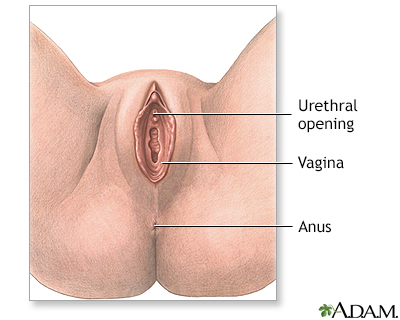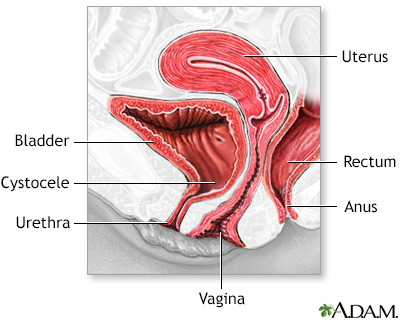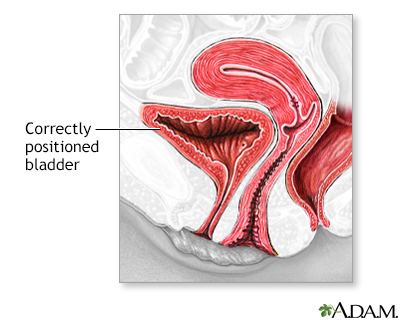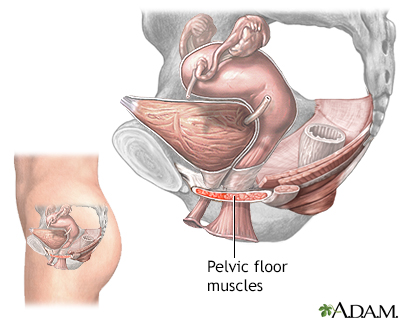Anterior vaginal wall repair (surgical treatment of urinary incontinence)
Normal anatomy
|
|
The vaginal opening lies just below the urethral opening, and just above the anal opening. The urethral opening, through which urine passes, leads to the bladder. The anus leads to the rectum. The vaginal opening leads to the vaginal canal, which leads to the uterus.
|
Indications
|
|
This procedure is used to repair the vaginal wall herniation that occurs with urethrocele, cystocele, or rectocele. This is occasionally performed to treat stress incontinence in women by supporting the bladder and urethra in its proper position, so it can function properly. As with most other surgical procedures, it is advised that you try medicines and bladder retraining therapy first, before resorting to surgical treatment.
|
Procedure, Part 1
|
|
To perform the anterior vaginal repair, an incision is made through the vagina to release a portion of the anterior (front) vaginal wall that is attached to the base of the bladder. The bladder and urethra are then stitched into the proper position. There are several variations on this procedure that may be necessary based on the severity of the dysfunction. This procedure may be performed using general or spinal anesthesia. You may have a foley catheter in place for one to two days after surgery. You will be given a liquid diet immediately after surgery, followed by a low residue diet when your normal bowel function has returned. Stool softeners and laxatives may be prescribed to prevent straining with bowel movements since this can cause stress on the incision.
|
Procedure, Part 2
|
|
Women treated with this procedure have approximately a 60% rate of success in relieving symptoms. You should avoid activities that cause an increase in abdominal pressure, such as straining, sneezing, and coughing. Try to tighten your pelvic muscles when coughing or sneezing to support the bladder. You may need to urinate at least every 2 to 3 hours, or perform clean intermittent self catheterization (CISC), to keep your bladder from getting too full and putting pressure on the stitches. You should avoid any activities that require lifting or straining. You may need to take stool softeners or gentle laxatives to prevent constipation and straining with bowel movements.
|

Review Date:4/10/2022
Reviewed By:Kelly L. Stratton, MD, FACS, Associate Professor, Department of Urology, University of Oklahoma Health Sciences Center, Oklahoma City, OK. Also reviewed by David C. Dugdale, MD, Medical Director, Brenda Conaway, Editorial Director, and the A.D.A.M. Editorial team.
The information provided herein should not be used during any medical emergency
or for the diagnosis or treatment of any medical condition. A licensed medical professional
should be consulted for diagnosis and treatment of any and all medical conditions. Call 911
for all medical emergencies. Links to other sites are provided for information only -- they
do not constitute endorsements of those other sites. © 1997-A.D.A.M., Inc. Any duplication or distribution of the information contained herein is strictly prohibited.
The Agency for Health Care Administration (Agency) and this website do not claim the information on, or referred to by, this site is error free. This site may include links to websites of other government agencies or private groups. Our Agency and this website do not control such sites and are not responsible for their content. Reference to or links to any other group, product, service, or information does not mean our Agency or this website approves of that group, product, service, or information.
Additionally, while health information provided through this website may be a valuable resource for the public, it is not designed to offer medical advice. Talk with your doctor about medical care questions you may have.




